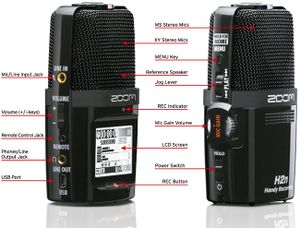Microphones
There are a number of different microphones that are used by YSTV. This page lists the several models and makes used, along with rough usage guides.
All of these mics (except the Zoom H2N) have XLR connectors - if you want to use them with our camera's have a look at Microphone Cables
AKG D130
Some old handheld that seems to be quite good actually
Audio Technica AT835b
Also known as a shotgun mic, the AT835b is a very directional condenser microphone primarily used at the end of a boom pole. Due to it's extreme directionality, it can be used to pick up sounds at a reasonable distance without picking up background noise. This does mean however, that the mic must be pointed directly at the source - it won't pick up anything if it's not.
Panasonic WM-665
Looks a bit like a rifle mic. Need to check what it's actually like
Samson PM6 Lavalier
These are our primary lavalier microphones. As with all lavaliers, mic placement is crucial when using them - too far from the subjects mouth and nothing will be picked up. Care has to also be taken to ensure the mic isn't touching the subjects throat or in a location that will cause hair or clothing to rub against it.
Sennheiser E825S
These are the hand-held mics with on-off switches.
Shure SM-57
Similar to the SM-58 in design, the SM-57 is a fairly robust unidirectional microphone. Our most common use for it is for acoustic instruments, however they are also very useful for when it's not possible to mic someone with a SM-58 or lavalier or several people need to be covered quickly. In both cases, they are normally used on the end of a mic stand.
Shure SM-58
Often considered the best touring microphone in existence, the SM-58's are arguably the only pieces of kit we have that are used regularly in professional environments. They are extremely robust - although please don't test exactly how robust. These are primarily used as handhelds or on a mic stand close to the source - they suffer from the proximity effect and so are less useful the further from the soure they get.
Zoom H2N Recorder
The Zoom H2N is a microphone/recorder purchased in Summer 2013. YSTV had previously borrowed a H2N for Campus: A Tale of Terrors, which was filmed solely using D-SLR cameras, as external microphones recorded directly to the D-SLRs result in noise. Film review show Front Row is also filmed using D-SLRs, as the Sony HVR-HD1000Es struggle to record in the low-light conditions of the cinema. Prior to the purchase of the H2N, a Sony HVR had to be brought along solely to record the rifle mic.
The H2N runs on AA batteries, and records to an SD card. Recordings made to the card can be transferred to the edit PCs either by using an SD card reader, or by connecting a Mini-B type USB cable to the H2N. When using the H2N, be sure to keep an eye on the LCD display - as this will tell you when the card is full, or when the batteries are flat. It is a good idea to check both of these before shooting.
The H2N has a number of significant advantages over the rifle mic. As it is independent of the camera, the lack of cable between the microphone and camera mean the boom operator has a lot more flexibility over where they stand - allowing better sound recording on wide or long shots. (Of course, one can use an extra XLR cable with the rifle mic to achieve the same result, but this is normally impractical.) Also, unlike the rifle mic, which is mono, the H2N is capable of recording sound in stereo, 2-channel and 4-channel surround.
The H2N also has both a line out and line in - this allows for other mics to be plugged into and recorded by the H2N and/or have the audio being recorded sent on to another device. The H2N was used like this for 4four, with the H2N sitting between the DJ desk and streaming laptop. Both connections are stereo jack sockets, so bodge microphone cables may have to be used.
Be careful when using headphones to monitor recording - if the cable becomes too taut, the line out can be damaged.
The manual can be read here.
Unidentified Mics
There are several 5v lavalier microphones with mono jack connecters - these must be used with a certain big grey box that converts 48v phantom power from the desk to the required 5v. These have also had all their clips stolen to keep the PM6's usable
